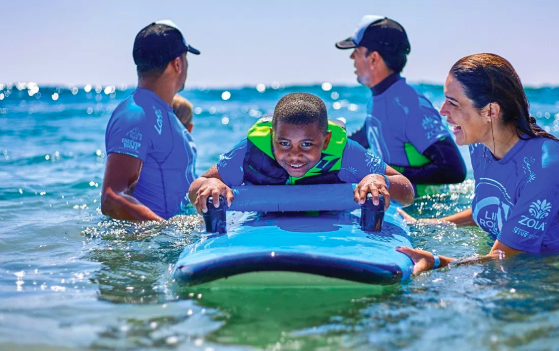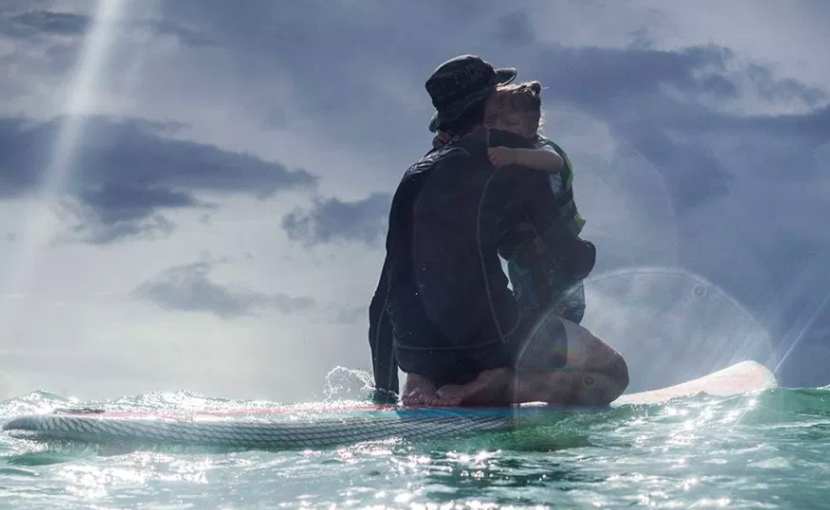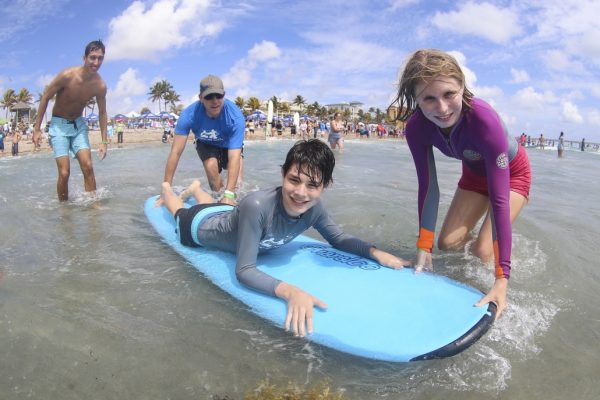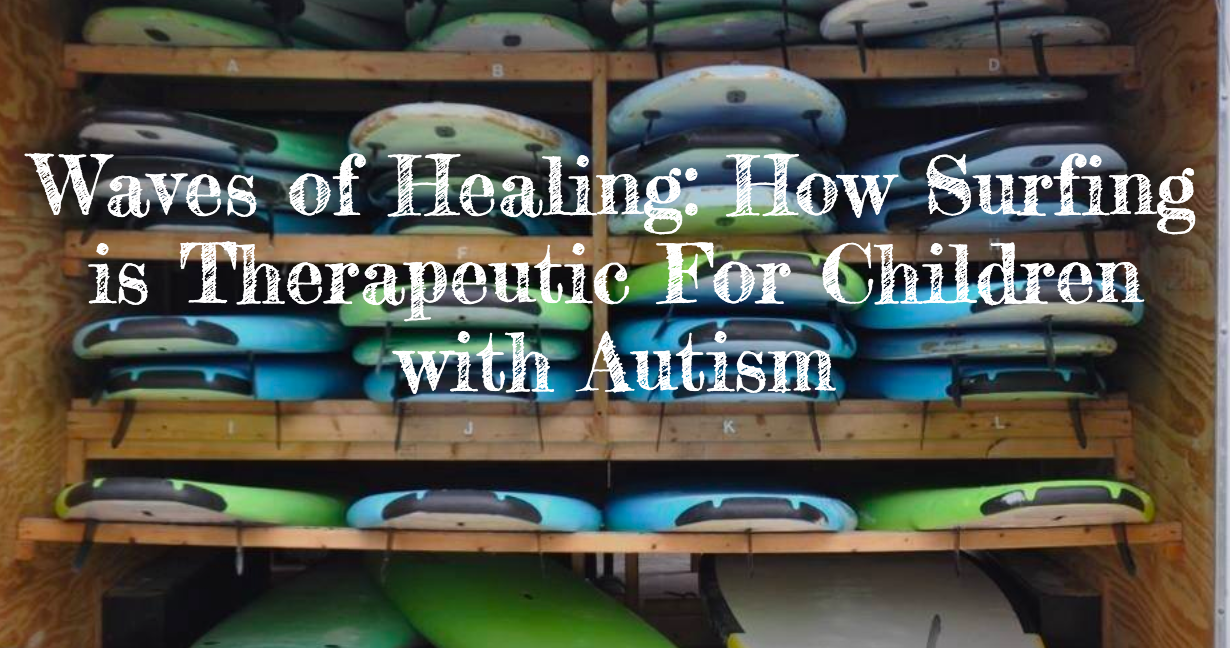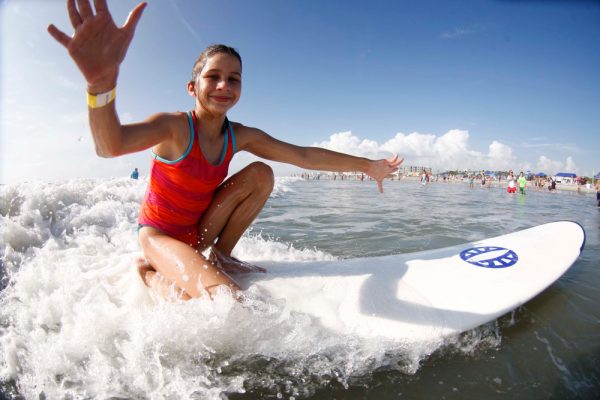“Waves of Healing is a powerful and inspirational book—a must-read for anyone with a loved one on the autism spectrum. You will laugh and you will cry as author Cash Lambert passionately shares both the struggles and the triumphs of the autism journey as sand and surf become a form of therapy and healing for so many families.”
—Amy KD Tobik, editor-in chief of Autism Parenting Magazine
“Surfers and water-lovers have long talked about the mysterious healing power of the sea. With empathy, attention to detail, and skillful storytelling, Cash Lambert shows how real that healing power is, taking us deep into the struggles of living with autism, deep into the joyful stories of children literally paddling and riding their way to greater health and happiness. This is such a hopeful and potentially life-changing read.”
—Jaimal Yogis, author of All Our Waves Are Water and Saltwater Buddha
“Waves of Healing is a big-hearted story that will delight anyone who loves the ocean. Saltwater is a universal balm—Cash Lambert knows this deeply, and his commitment to sharing his experience in the surf with autistic kids and their families makes for an inspiring tale, beautifully told.”
—Susan Casey, author of Voices in the Ocean: A Journey Into the Wild and Haunting World of Dolphins
“As a firm believer in the many blessings of surf therapy for children on the spectrum, I was delighted to read Cash Lambert's uplifting and validating account of a season on the shore with Surfers for Autism. He writes with the head and heart of a surfer about the thrilling transformation that finds many children and families on the back of their shared surfing experiences—a must-read for anyone who accepts the healing power of stoke, and the rich, restorative energy to be mined from a community of like-minded souls.
—Daniel Paisner, co-author of Scratching the Horizon: A Surfing Life
“Perfect waves and empty beaches, the sport of surfing is easily romanticized, but at its core it possesses the power to change one's life. For those who struggle with autism, surfing can mean a freedom and joy like they've never experienced. Author Cash Lambert has taken the time to tell the story of this unlikely relationship. He tenderly makes the case for the healing powers of the sea, as well as how and why it can be so therapeutic for those on the autism spectrum. Waves of Healing will stoke you out, it will tug on your heartstrings, and it will make you reconsider what those with autism are capable of—and how one good ride can change everything.”
—Jake Howard, surf writer and editor of First Priority: A Father's Journey in Raising World Champion Surfer Carissa Moore
“Often, it’s difficult to understand the everyday struggles and small milestones that families raising a child with autism face, but Cash Lambert’s firsthand ride-along—both on land and in the sea—truly puts their lives into perspective. A deeply honest and eloquent account, Waves of Healing is a story of hope, and a discovery of what the therapeutic power of the ocean—and organizations like Surfers For Autism—can do.”
—Beau Flemister, former editor-at-large of Surfing Magazine and author of In the Seat of a Stranger’s Car
“Waves of Healing shows how a creative, nature-based approach is often the best way for healing and hope to flow into the lives of those coping with autism and into all lives. Lambert has written a book that is both important and profound.”
—David Athey, Professor of English, Palm Beach Atlantic University, author of Joan of the Everglades
Void Magazine Features "Waves of Healing"
Void Magazine allowed me to contribute to their annual “Do Good” magazine issue, where I wrote about how surfing is changing lives — no co-pay required.
The first time I saw surfing change the lives of children with special needs, I was standing with a surfboard on the sands of Jacksonville Beach.
While it seemed like an ordinary beach day—waist-high swell filled the area just south of the pier as beachgoers flooded the wooden walkways—what was happening in the water was anything but ordinary.
On this day, a nonprofit organization called Surfers for Autism offered to take children with autism surfing. If you aren’t familiar with autism, it’s a developmental disability that sees children struggle against difficulties with social skills, repetitive behaviors, and communication. This condition irrevocably changes the life of the child and the lives of everyone around them. According to the CDC, it affects one in 59 children.
But at this surf event, those with an autism diagnosis were not walking statistics. Instead, they were surfers.
Earlier in the day, families filled the beach, creating a makeshift city from their tents. Reggae music pumped out of the loudspeakers and surfboards lined the sand.
After a volunteer meeting, surfing—and the miracles—began.
Here’s how it worked: an army of volunteers stood in a line parallel to the beach, and were introduced by SFA staff to participants. Some children were excited; others looked nervous and quiet, and some were in absolute meltdown, crying and sending sand in all directions.
But none of that mattered once they entered the water, hand in hand with surf volunteers who called Jacksonville home.
When the right wave came, volunteers pushed the participants atop surfboards while chanting phrases like “up up up!” and “You can do it!”
Children diagnosed with nonverbal autism—who had rarely said any words to even their parents—were suddenly cheering and saying things like “I did it!” and asking for more with phrases like “Another wave!” Participants who were previously screaming on the beach in fear were suddenly calm, relaxed, and smiling. Some children were riding waves into shore as if they’d been doing so for years. Families and other volunteers formed a loud cheering section on the beach. Mothers and fathers cried.
The surf session lasted all day. Speaking with the parents during the event, I realized there was more to the unique relationship between surfing and autism. This wasn’t just a fun event to attend on the weekends—surfing was therapeutic for these children. And there was no copay required.
An avid surfer myself, I began to wonder exactly what made surfing therapeutic. What’s more, I was curious as to why a select group of families attended each Surfers for Autism event during their “Surf Tour.” Since the organization’s genesis in 2008, there have been 10-13 events up and down the Florida coast and these self-proclaimed groupies didn’t miss an event.
The inaugural Jacksonville Beach event was in 2010. I spent the next four years with the organization, seeking to understand how surfing is therapeutic from a scientific and a personal level. I went to therapy sessions, birthday parties, and became part of this eclectic surfing family. All the while, I wrote down what I heard and experienced.
I tell these families’ stories in Waves of Healing: How Surfing Changes the Lives of Children with Autism, published by Hatherleigh Press and Penguin Random House, which was released this year. These are stories about the struggles children with autism face—the struggle to stand on a surfboard, the struggle to communicate, the struggle to make progress in a world which accepts “normal” and rejects all else. But they’re also stories of breakthroughs, of authentic joy and unbridled excitement as the children learn to see their world from a whole new perspective — standing tall atop a surfboard, riding a wave all their own.
In my research, I learned how surfing can affect children with autism, how it can have a tremendous impact on parents and how it can unite a community.
In the book Blue Mind: The Surprising Science That Shows How Being Near, In, On, or Under Water Can Make You Happier, Healthier, More Connected, and Better at What You Do, scientist Wallace J. Nichols explores scientific studies on why water is therapeutic, which I stumbled upon for the writing of my book. Here’s a short excerpt:
Nichols writes: “There are all kinds of theories about why this happens. The water is stimulating visually, which fulfills some children’s sensory needs; water provides a safe and supported environment’ that surrounds the body with ‘hydrostatic pressure’ that ‘soothes and calms’ (as another expert said, it feels like the ultimate hug). Learning new motor skills like swimming, surfing or paddleboarding can have ‘a broad-ranging impact on the nervous system,’ according to William Greenough at the Beckman Institute at the University of Illinois: “There’s increased blood flow to crucial neurons, and the reshaping of abnormal structures in the front brain. But beyond that, surfing may be a vehicle to an emotional breakthrough, a way of reaching under the mask and perhaps connecting to kids like these.” Trying to balance and ride waves also provides them with a clear focus and keeps them in the present moment.
Not only is surfing life-changing for those with autism. It also transforms the lives of parents, something I saw firsthand. You see, thanks to these organized surf events, for the first time families have a support network, someone to relate to and discuss their challenges with. On the beach in Jacksonville, as well as at other events, commonality was found, and bonds were born.
I also saw communities rallying around these events and children with special needs. In city after city, food and water were donated for the families. Policemen and firefighters parked their cars in the beach parking lots so the participants (with sand covering their feet) could look inside and even finger paint on the exterior. Plus, local surfers were teaching their passion to participants and sharing in their excitement. To this day, many families have framed photos of their children standing alongside these volunteers on the beach.
My book is not a story of the past. It is a story that, like one’s surfing ability, continues to evolve.
Here’s what I mean: Surfers for Autism has held its annual Jacksonville Beach event for a decade and expects to continue the tradition, inviting familiar and new faces to the beach each year. Attend an SFA event and you’ll find participants who had their lives changed by surfing years ago are now helping others with the same diagnosis experience therapeutic feelings, serving as volunteer surf instructors. Or you can attend other surf therapy events. Thanks to this rapidly growing trend, there are now dozens of surf therapy organizations along America’s coastlines.
As long as there are waves, there will be people riding waves of healing. Some of them though, need your help.
Watch: Live Interview on CGTV
“CGTN's Rachelle Akuffo spoke to Cash Lambert, author of 'Waves of Healing: How Surfing Changes the Lives of Children with Autism,' about the benefits of surfing for children with ASD.”
I had the opportunity to talk with the Chinese Global Television Network about how surfing is therapeutic for children with autism and other special needs. You can watch the full interview here:
Adventure Sports Network Coverage of "Waves of Healing"
Stoked to be interviewed in an amazing article written by Jon Coen for the Adventure Sports Network about the healing powers of the sea. You can read the full article by clicking here.
Cash Lambert, the former editor of Hawaii’s “Freesurf Magazine” recently published the book “Waves of Healing.”
“In my research, I learned there are many ways surfing is therapeutic for children with autism, including studies from Wallace J. Nichols’ “Blue Mind,” which theorized that part of surfing’s therapeutic nature is because it requires participants to focus on the now,” says Lambert. “It’s what’s happening in the moment. Instead of thinking and acting on anxiety or stress, participants often think about what’s in front of them: a fast moving wave.
“When you combine that focus to what happens in your brain while you surf – a release of chemicals that foster motivation, movement and euphoria, such as dopamine and endorphins – the stage is set for significant progress to occur, or what’s known as ‘breakthroughs.’ I saw these breakthroughs with my own eyes.”
He observed children previously diagnosed as “nonverbal,” start speaking about their surfing experience.
“Children with autism who are hesitant to touch even their loved ones were holding hands with surf volunteers as they wade into the sea together,” Lambert continues. “Some participants even having a breakdown – screaming, kicking sand. But once they’re in the water, they become calmer and happier than their parents can recall them being.”
Freesurf Magazine: "North Shore Writer Releases New Book"
This article was originally published by Freesurf Magazine.
The following is an excerpt from former Editor of Freesurf Magazine Cash Lambert’s new book Waves of Healing: How Surfing Changes the Lives of Children with Autism. The 208 page book, published by Hatherleigh Press in partnership with Penguin Random House, explores how surfing is therapeutic on a scientific level as well as how it’s transformed the lives of 8 families over the course of a decade.
I had experienced the therapeutic properties of water already, at least to some degree.
There had been multiple instances when, after jumping into the ocean, a lake or a pool, I simply felt better; more relaxed, more present. Not to mention, I’d been completely hooked on surfing since that first moment standing atop a surfboard, sliding down a wall of solid water at Waikiki Beach—the Mecca of surfing.
Point is, surf therapy isn’t new to our culture. In fact, there’s tens of organizations from “sea to shining sea” that take participants surfing, from those with special needs to military members with PTSD and more. The resounding result is that the participants smile from ear to ear, and experience specific therapeutic benefits. They too become hooked.
In the book Blue Mind: The Surprising Science That Shows How Being Near, In, On, or Under Water Can Make You Happier, Healthier, More Connected, and Better at What You Do—published in 2014—author Wallace J. Nichols, a scientist/researcher, devotes 260 pages, with over 40 pages of references and citations, to scientific studies on the question of why water is therapeutic, injecting commentary on topics including why we’re drawn to water in the first place, why we respond to its beckoning color so well, and how exactly it can make us feel better. More than anything, the text seems to signify that research on water and the true effects of its healing properties, much like in the autism field, is ever expanding. According to Nichols, there’s science behind why those who surf are likely to become hooked.
“…Dopamine release is associated with novelty, risk, desire, and effort activity; it’s also a key part of the system by which the brain learns. All of these factors, Zald points out, are present in surfing: ‘as surfers are first learning, there’s an amazing burst of dopamine simply when they stand on the board…Novelty? Check. Risk? Check. Learning? Check. Aerobic activity? Check. Dopamine? In spades.” But that’s not all…aerobic exercises (such as surfing) produce endorphins, the opioids that affect the prefrontal and limbic areas of the brain involved in emotional processing, and create the feeling of euphoria, known as runner’s high. The beauty of the natural environment where people surf also increases the sense of a peak emotional experience. Add the dopamine, the endorphins, and the natural setting to the adrenaline rush produced by the amygdala’s fight or flight impulse when a surfer is faced with a large wave (or a wave of any kind when you’re first starting out), and you’ve got a seriously addictive experience.” (Nichols, Wallace J. Blue Mind: The Surprising Science That Shows How Being Near, In, On, or under Water Can Make You Happier, Healthier, More Connected, and Better at What You Do. 115-16. Print.)
I dug further into Nichols’ work to find out how water, surfing and even just being on a surfboard can be therapeutic for children with autism.
“There are all kinds of theories about why this happens. The water is stimulating visually, which fulfills some children’s sensory needs; water provides ‘a safe and supported environment’ that surrounds the body with ‘hydrostatic pressure’ that ‘soothes and calms’ (as another expert said, it feels like the ultimate hug). Learning new motor skills like swimming, surfing or paddle boarding can have ‘a broad ranging impact on the nervous system,’ according to William Greenough at the Beckman Institute at the University of Illinois: “There’s increased blood flow to crucial neurons, and the reshaping of abnormal structures in the front brain. But beyond that, surfing may be a vehicle to an emotional breakthrough, a way of reaching under the mask and perhaps connecting to kids like these.” Trying to balance and ride waves also provides them with a clear focus and keeps them in the present moment—neurobiologist Peter Vanderklish believes that the beauty of surfing ‘turns the focus of these kids inside out. They’re pulled out of themselves by having to live in the moment, and all their anxieties push aside.’” (Nichols, Wallace J. Blue Mind: The Surprising Science That Shows How Being Near, In, On, or under Water Can Make You Happier, Healthier, More Connected, and Better at What You Do. 175. Print.)
While these theories are speculative, they do begin to paint a picture on an otherwise blank canvas as to why surfing and water do indeed aid in a progression of sorts, as well as how water can help children on the spectrum say their first words.
“Perfect waves and empty beaches, the sport of surfing is easily romanticized, but at its core it possesses the power to change one’s life. For those who struggle with autism, surfing can mean a freedom and joy like they’ve never experienced. Author Cash Lambert has taken the time to tell the story of this unlikely relationship. He tenderly makes the case for the healing powers of the sea, as well as how and why it can be so therapeutic for those on the autism spectrum. Waves of Healing will stoke you out, it will tug on your heartstrings, and it will make you reconsider what those with autism are capable of—and how one good ride can change everything.” —Jake Howard, surf writer and editor of First Priority: A Father’s Journey in Raising World Champion Surfer Carissa Moore
Autism Journey: How Surfing is Therapeutic
This article was originally published by Autism Journey.
I volunteered at a surfing for autism event with a simple goal: to impact the lives of the participants with autism. But I had no idea that it would impact my life.
Like most families and volunteers, I will never forget that day. Attend a surf therapy event and you’re bound to see children with autism riding waves to shore as a crowd cheers and claps; you’ll see those not receptive to touch holding the hands of volunteers; you’ll hear children diagnosed as “nonverbal” speaking words and so much more. Plus, with this form of therapy, there’s no co-pay required.
Surf therapy has gained momentum in recent years, with organizations sprouting up in coastal beach towns around the world.
These organizations, along with the families who attend surf events, claim that not only is surfing is therapeutic—it’s a life changing. In order to find out why, I spent years with families and their children on the autism spectrum, examining just how surfing has changed their lives as well as the science behind it all.
The result is the book Waves of Healing: How Surfing is Therapeutic for Children with Autism, published by Hatherleigh Press in partnership with Penguin Random House.
The book tells stories about the struggles children with autism face—the struggle to stand on a surfboard, the struggle to communicate, the struggle to make progress in a world which accepts “normal” and rejects all else.
But they’re also stories of breakthroughs, of authentic joy and unbridled excitement as they learn to see their world from a whole new perspective—standing tall atop a surfboard, riding a wave all their own.
“Often, it’s difficult to understand the everyday struggles and small milestones that families raising a child with autism face, but Cash Lambert’s firsthand ride-along—both on land and in the sea—truly puts their lives into perspective. A deeply honest and eloquent account, Waves of Healing is a story of hope, and a discovery of what the therapeutic power of the ocean—and organizations like Surfers For Autism—can do.”
—Beau Flemister, former editor-at-large of Surfing Magazine and author of In the Seat of a Stranger’s Car
Exploring new avenues of therapy for those with autism, with therapeutic and extraordinary results, Waves of Healing is a snapshot of hope, courage, and human perseverance.
Not only did I see an autism community changed by the transformative power of the ocean and surfing—I realized that by volunteering, by giving yourself to a cause, you receive just as much in return as the participants do.
Waves of Healing: How Surfing Changes the Lives of Children with Autism is available in bookstores around the world, including Amazon, Barnes and Noble, Wal Mart, and Target.
Tampa Bay Times: ‘Waves of Healing’ shaped by author’s admiration for Tom Wolfe
This article was originally published by The Tampa Bay Times.
The former Floridian's new book is about the organization Surfers for Autism.
We recently caught up with Lambert, a former Florida resident now living in Oahu, Hawaii. His book, Waves of Healing, will be published in March. Based on Surfers for Autism, a volunteer organization supporting youth on the autistic spectrum while introducing them to surfing and time on the water, the book features several youngsters with ties to the Tampa Bay area. Lambert, 27, holds a journalism degree from Palm Beach Atlantic University and previously served as the editor of Hawaii's Freesurf Magazine. His work has been featured on the Outdoor Channel and ESPN Outdoors and in Autism Parenting Magazine, Surfing Magazine and Eastern Surf Magazine.
What's on your nightstand?
I'm rereading my all-time favorite author, Tom Wolfe's The Right Stuff. I am also reading Celebration of Discipline by Richard Foster. It's about spirituality and bettering yourself. And I also have my own book, Waves of Healing, out. I'm proud of it.
Did you read The Right Stuff before you became a journalist, and did Wolfe influence your style for Waves of Healing?
I stumbled upon the New Journalism era in the middle of studying in college. I love how he always puts his characters first. I definitely would not say that my book is like what he has written, but it is, he is, what I'm going for.
How did you come up with the idea for Waves of Healing?
The genesis of the whole project came from volunteering with Surfers for Autism, and then one day, I was at Barnes & Noble. I saw books about certain things, and I had a thought on how no book had been written on surfing and autism. It is such a positive environment. I thought it should be done. I gave myself a three-year plan. The first year was for research. The second year was for writing, and the third year was for finding a publisher. I literally researched by buying a ton of books and looking at how other authors frame their stories and looking for books with multiple characters. I'm proud of how it all turned out. It is a book about children with autism and having struggles, but it is also about breakthroughs.




